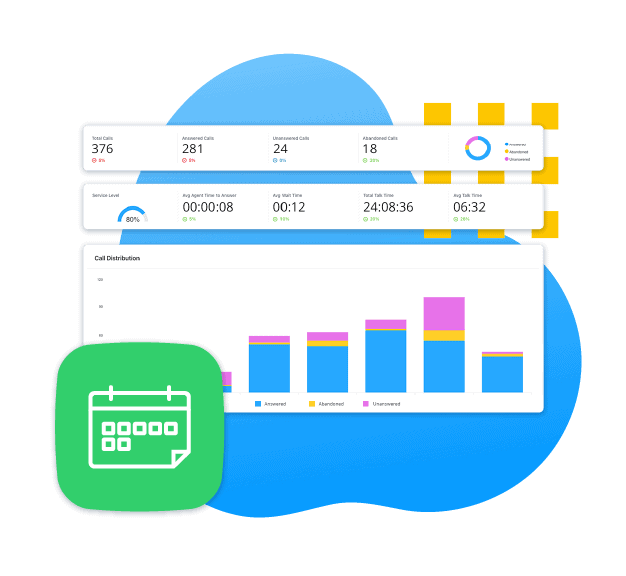6 Tips for Managing Your International Remote Workforce
Managing a remote workforce with employees around the world is a learning experience for most. With many call center agents working from home, business leaders need supporting VoIP tools to help them manage their teams effectively. Read on to learn more about actionable tips you can implement today in your call center!

Managing a remote workforce, especially one that spans countries and time zones, is a learning experience for even the most seasoned managers. Remote teams are becoming more common as businesses look to retain the best talent. Before the COVID-19 pandemic, an estimated 20% of all employees worked from home. Now, that number has tripled.
More call centers are offering work-from-home positions as a way to reduce health risks, provide a better work-life balance, access a larger talent pool, ensure call continuity across their markets, and leverage increased productivity. As remote team management becomes more prevalent, contact center managers and operations leaders are taking a hard look at their tech stack, internal processes, and collaboration tools to ensure success. In this post, we’ll highlight key ways you can successfully manage and measure the achievements of your remote teams from anywhere in the world.
Advantages of Growing Your Remote Workforce
While having a remote workforce can come with its own challenges, businesses are seeing a substantial upside when done correctly. To start, offering the ability to work from anywhere creates several talent acquisition benefits:
- Access to global talent. People who are unable to commute to an office because of transportation challenges, live outside of your city, state, or country lines, or have a taut personal schedule, can now consider your open position(s).
- Lower health risks. When potential employees are not required to attend work in a crowded office, they can better protect their health while still being gainfully employed. And from a business perspective, you can keep your workforce operating at full capacity.
- Better work-life balance. With no commute, many employees find they have more time for their responsibilities and leisure pursuits while still maintaining the same level of work output.
Paired with the appropriate technologies and internal processes, businesses can also recognize improvements through:
- More productive individuals. When people can work wherever they feel most comfortable, they’re often more productive. 30% of employees say they’re more engaged with work at home.
- Better global phone coverage. If you need to ensure coverage of your phone lines, having local agents in different time zones provides customers with assistance 24/7, including during regional and national holidays.
- Better employee retention: 83% of people agree that the ability to work remotely makes them happier. The benefits of flexible scheduling and improved work-life balance mean employees are often more loyal to companies that support remote work setups.
- Reduced real estate expenses. While you still need to provide sufficient equipment and supplies for employees to fulfill their roles, with most or all of your team working from home, or their preferred location, you don’t need to acquire more space for them.
Common Challenges of Remote Work
Whether you already have an established remote team or are planning to build one out, to make it a successful endeavor there are a few areas to consider:
- Tech Stack & Compliance. As a call center manager, ensuring your team has the right tech stack that enables them to do their job anywhere in the world is critical. Knowing how those technologies seamlessly fit into your business ecosystem and align with compliance protocols will be key also.
- Blindspots. As a manager, it can be difficult to have a complete picture of how productive your team is and how much work is getting done. With the right tools and processes in place, you’ll be able to manage your team as if they were in the office.
- Coaching Opportunities. Even though agents are remote, they still want to learn and grow their careers. As a leader, you’ll need to be able to coach and manage your teams in real-time to ensure KPIs and customer success metrics are being met.
- Onboarding. Onboarding new employees in a remote world can be tricky if you’re not prepared. Make sure to find the technologies that accelerate onboarding and make it a seamless part of the new employee experience.
- Team Building. With employees spread throughout the globe, building and maintaining trust will be important. Find ways to bring your team together so knowledge transfer is something continuously taking place.
- Motivation. Working remotely can get stale fast. Keeping your remote team motivated and finding unique ways to keep engagement high will be important.
Furthermore, you may have to work with your remote agents to ensure their home environment delivers a stable and reliable internet connection. Some individuals live in areas with irregular service, which can result in quality issues such as packet loss, voice delays, and dropped calls that can deter a productive conversation. Having the right tools in place to proactively measure your team’s connectivity will help you manage with ease. Our customers use AVOXI’s call insights to monitor their call quality performance in real-time to ensure customer satisfaction remains high no matter their team’s locations.
How to Support Your International Remote Workforce
Now that we’ve covered some of the benefits and challenges of supporting an international remote workforce, let's get into some tactical tips on how to ensure your team is operating with top productivity and ROI.
1. Ensure technology resources are accessible
As mentioned above, ensuring your team is equipped with the right cloud-based solutions will be critical to your success. While there are many tools remote call centers can leverage, it's important to select the ones that can improve performance and integrate easily with others. Global communications platforms provide critical call management software that can help you integrate all your tools in one place including:
- Messaging/collaboration apps
- Helpdesk software
- Video conferencing tools
- CRM and pipeline management apps
- File management apps
- Phone system environment (cloud or PBX)
Since the global pandemic, other popular tools like Microsoft Teams have quickly gained popularity as a collaboration tool - a 70% spike to be exact! As more and more tools become available in this new remote world, leaders will be tasked to ensure these tools play nicely with one another, syncing seamlessly to ensure customer success.
AVOXI customers benefit from seamless integration with our global communications platform and a variety of CRMs, helpdesk, and collaboration tools including MS Teams. With the ability to easily route our global voice capabilities into the technologies of their choice, international businesses can strengthen their operations regardless of their tech stack.
At the end of the day, the tools you deploy must serve a purpose and be easy to use for your teams. Otherwise, it could drag productivity.

2. Automate your team's workload
As you would ensure your applications are accessible, selecting technologies that simplify work for your teams is a resourceful way to optimize your tech stack for better conversations. With computer telephony integration (CTI) into the business world’s most popular tools, managers can easily automate their agents’ work processes and eliminate tedious tasks. Some ways that VoIP integrations are fueling profitable calls include:
- Automatic call logging to boost resolutions
- Providing contextualize softphone details referencing call history and customer information
- Establishing a new local presence in hard-to-reach locations
- Offering queue callback and click-to-dial functionality for better CSAT
- Consolidating global number inventory into a single, manageable portfolio
When your teams can work smarter, together, you can improve the experience your customers are having with your brand. Choose your toolkit applications wisely. And when it comes to your cloud communications, ensure it has the network reliability and flexibility to grow with you as your business needs change.
3. Set clear productivity goals
Setting clear productivity goals is a no-brainer in any work environment, but it’s especially important for remote employees. Productivity goals vocalize performance expectations and hold everyone accountable for their level of output. Establishing and maintaining these expectations ensures everyone is on the same page and working toward mutual success.
Tracking progression requires the right call management software. With this technology in place, you’ll have the ability to monitor and review holistic SLA and call metric performance across your organization.
Pro tip: Look into the reporting tools offered within your software to track performance activity and use the data to identify gaps to improve efficiencies. With AVOXI, we enable you to:
- Track real-time and historical reports
- Monitor service-level KPIs
- Share insights and schedule reports
- Improve performance with live call monitoring and analytics
Encouraging your teams to frequently see how their performance stacks up against established benchmarks will allow them to evaluate their output and course-correct as needed to get back on track.

4. Offer real-time call coaching and training
Just like accessible and effective technologies, your teams need regular training on new implementations and optimized processes. To do so quickly and efficiently, incorporating tools like call recording and call monitoring will increase your benchmark successes.
Managers can conduct optimized training sessions that boost customer loyalty and productivity for novice and experienced staff easily with recorded feedback and exchanges. Performance management is accelerated even further through live coaching tools: monitor, whisper, and barge. Call monitoring, for example, allows managers to listen in on conversations happening to ensure quality standards are met across their teams.
With functionality like call whispering, which allows managers to coach an agent on the line without the customer hearing it, you’ll be able to instill confidence in your agents at the moment they need assistance. To fully back up your team, call barging lets you join in and guide the conversation when warranted. These live call coaching tools not only simplify managing remote teams, but it’s also essential for a profitable customer experience.
5. Delegate call tasks efficiently
A good manager not only trains and motivates their team but knows how to delegate tasks to the right person at the right time. This is where a fluid call system configuration is imperative for happy agents and customers.
Call routing can help you efficiently apportion your team’s workload. A well-defined call routing system helps even out employees’ cases, especially during call volume peaks, while connecting them with the callers they’re best suited to help.
There are a few of the common call flow strategies to consider:
- TOD/Time Based: Route calls to an agent who is on the clock when the call comes in. This option is useful for international companies with customers and offices across multiple time zones.
- Geographic Routing: Route inbound calls to the closest location to the caller based on their dial code or location ID. This is especially useful for companies that operate internationally.
- Least Used: Route calls to an agent who has been waiting to handle a call the longest of anyone on their team. In other words, send the caller to an agent who hasn’t had a case in a while. This strategy helps ensure an even workload among all team members.
- Skills-Based Routing: Also known as intelligent routing, route the call to the agent whose skills best match the needs of the inbound caller. For example, if the caller selects a certain language from an interactive voice response menu, their call is routed to an agent who also speaks that language.
- Round Robin: Route incoming calls based on a predetermined list of agents who will answer. It assigns calls to an agent based on the order in which calls come in. This strategy is useful for businesses with a large call volume and versatile team members.
However you decide to delegate tasks, make sure you’re accounting for your employees’ professional strengths and existing workload as well as your call volume.
6. Assemble a well-rounded team
And finally, the best teams complement each others’ strengths. When assembling your remote team, or backfilling a position, think about which traits are most important to be a successful call center agent and hire for those skills. Look beyond the resumes to the “soft” skills your team members can offer, too. You’ll need people who are strong communicators, ambitious, and goal-driven.
Traits that call center leaders say work best in remote environments include:
- Problem Solving. Agents must be able to think on their feet and adapt to different situations quickly to improve customer service KPIs and move through the queues.
- Self-Management. Proactively reaching out to customers, following up on interactions and open cases strengthens customer relationships and loyalty.
- Active Listening. Allowing the customer to speak on their issues uninterrupted enables agents to respond thoughtfully and with an action plan.
- Communication. The ability to transfer knowledge and ask discovery questions at appropriate times promotes clarity, professionalism, and more productive conversations.
- Empathy. Being empathetic helps callers feel supported and valued even during tough situations.
Better Manage Your Remote Team with Cloud Communications Software
Managing a remote team comes with its challenges but can also be very rewarding for everyone. Once you and your team set expectations for communication, define your goals, and ensure everyone has the tools and resources to achieve those goals, you’re sure to find your groove and blow your KPIs out of the water!
One key tool for remote workforce success is cloud communications software. This type of software eases inbound and outbound calls by making call routing seamless, easily integrating with other essential technologies, and simplifying call monitoring. Whether it’s voice, chat, or contact center solutions (or all three), you’ll have everything you need to monitor your inbound and outbound conversations.
AVOXI’s cloud communications platform has numerous integrations, including CRMs, collaboration tools like MS Teams, CCaaS, and PBX systems to help analyze patterns, automate tasks, and expand voice reach so your agents can focus on the work that matters. Setting up global communications for an international remote team is easy with AVOXI.
eBook
Reducing Costs
in Your Global Voice Infrastructure
Modernizing your on-premise voice in the cloud reduces TCO, so you can scale and grow your market coverage. Get the eBook and lower voice spending.

